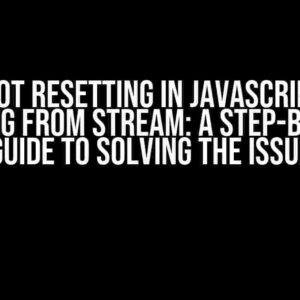Are you tired of pulling your hair out due to the inexplicable 504 (Gateway Timeout) and 502 (Proxy Error) errors in your .NET Core code, despite the HTTP request working seamlessly in Postman and curl? You’re not alone! In this article, we’ll embark on a thrilling adventure to uncover the root causes of these errors and provide you with actionable solutions to get your HTTP requests up and running in no time.
Understanding the HTTP Request Landscape
Before we dive into the troubleshooting process, it’s essential to grasp the basics of HTTP requests and the tools involved. HTTP requests are the backbone of web communication, allowing clients to interact with servers and retrieve or send data. In our scenario, we have:
- Postman: A popular API testing tool that sends HTTP requests to a server and displays the response.
- Curl: A command-line tool for transferring data specified with URL syntax.
- .NET Core Code: A C#-based framework for building web applications and APIs.
When an HTTP request is sent, it passes through multiple layers, including the application, framework, operating system, and network. Each layer can introduce its own set of complexities, making it challenging to identify the source of the issue.
The 504 Gateway Timeout Error: A Closer Look
The 504 error occurs when the server, acting as a gateway or proxy, does not receive a response from the upstream server within a specified time frame. This timeout can happen due to various reasons, such as:
- Server overload or high latency.
- Network congestion or packet loss.
- Poorly configured proxy or gateway settings.
- Faulty or misconfigured load balancers.
In the context of .NET Core code, the 504 error might be related to the following:
- Incorrectly configured
HttpClientorHttpClientHandler. - Inadequate timeout settings or connection pooling.
- Missconfigured proxy settings or credentials.
The 502 Bad Gateway Error: Unraveling the Mystery
The 502 error occurs when the server, acting as a gateway or proxy, receives an invalid response from the upstream server. This error can be triggered by:
- Server misconfiguration or incorrect response formatting.
- Network issues or packet corruption.
- Malfunctioning load balancers or proxy servers.
- Incompatible or outdated browser or client software.
In the context of .NET Core code, the 502 error might be related to:
- Incorrectly configured
HttpClientorHttpClientHandler. - Inadequate error handling or exception logging.
- Misconfigured proxy settings or credentials.
Troubleshooting the Errors: A Step-by-Step Guide
To tackle the 504 and 502 errors in your .NET Core code, follow these steps:
Step 1: Verify HTTP Request Settings
Double-check your HTTP request settings, including:
Timeoutsettings: Ensure the timeout value is sufficient for the request to complete.Proxysettings: Verify the proxy URL, username, and password (if applicable).Connection Pooling: Check if connection pooling is enabled and properly configured.
var httpClient = new HttpClient();
httpClient.Timeout = TimeSpan.FromSeconds(30); // Increase timeout to 30 seconds
httpClient.Proxy = new WebProxy("http://proxy.example.com:8080", true); // Set proxy URL and credentials
Step 2: Inspect HTTP Request Headers
Verify the HTTP request headers, including:
Content-Type: Ensure the content type is correctly set.Accept: Verify the accept header is correctly set.
var request = new HttpRequestMessage(HttpMethod.Get, "https://api.example.com/data");
request.Headers.Accept.Add(new MediaTypeWithQualityHeaderValue("application/json"));
Step 3: Enable Error Logging and Debugging
Enable error logging and debugging to capture detailed information about the error:
var httpClient = new HttpClient();
httpClient.Dispose += (sender, args) => {
Console.WriteLine("HttpClient dispose event triggered");
};
var response = await httpClient.GetAsync("https://api.example.com/data");
if (!response.IsSuccessStatusCode)
{
Console.WriteLine("Error: " + response.StatusCode);
Console.WriteLine("Reason: " + response.ReasonPhrase);
}
Step 4: Test with a Different HttpClient Instance
Create a new instance of HttpClient to isolate the issue:
var httpClient = new HttpClient();
var response = await httpClient.GetAsync("https://api.example.com/data");
Step 5: Verify Server-Side Configuration
Check the server-side configuration, including:
- Server logs: Verify the server logs for any errors or issues.
- Proxy settings: Check the proxy settings on the server-side.
- Load balancer configuration: Verify the load balancer configuration.
Conquering the 504 and 502 Errors: Best Practices
To avoid the 504 and 502 errors in your .NET Core code, follow these best practices:
Best Practice 1: Use a Robust HttpClient Instance
Create a single instance of HttpClient and reuse it throughout your application:
public class HttpClientFactory
{
private static readonly HttpClient _httpClient;
static HttpClientFactory()
{
_httpClient = new HttpClient();
_httpClient.DefaultRequestHeaders.Accept.Add(new MediaTypeWithQualityHeaderValue("application/json"));
}
public static HttpClient GetHttpClient()
{
return _httpClient;
}
}
Best Practice 2: Implement Connection Pooling and Caching
Enable connection pooling and caching to improve performance and reduce errors:
var httpClient = new HttpClient(new HttpClientHandler
{
MaxConnectionsPerServer = 10,
Proxy = new WebProxy("http://proxy.example.com:8080", true)
});
Best Practice 3: Configure Error Logging and Debugging
Implement robust error logging and debugging mechanisms to capture detailed information about errors:
var httpClient = new HttpClient();
httpClient.Dispose += (sender, args) => {
Console.WriteLine("HttpClient dispose event triggered");
};
var response = await httpClient.GetAsync("https://api.example.com/data");
if (!response.IsSuccessStatusCode)
{
Console.WriteLine("Error: " + response.StatusCode);
Console.WriteLine("Reason: " + response.ReasonPhrase);
}
Best Practice 4: Verify Server-Side Configuration
Regularly verify the server-side configuration, including proxy settings, load balancer configuration, and server logs:
| Server-Side Configuration | Verification Frequency |
|---|---|
| Proxy settings | Daily |
| Load balancer configuration | Weekly |
| Server logs | Hourly |
Conclusion
In this article, we’ve embarked on a thrilling adventure to unravel the enigma of 504 and 502 errors in .NET Core code. By understanding the basics of HTTP requests, identifying the root causes of these errors, and following best practices, you’ll be well-equipped to tackle these issues head-on. Remember to verify HTTP request settings, inspect HTTP request headers, enable error logging and debugging, test with different HttpClient instances, and verify server-side configuration. With these strategies in your toolkit, you’ll be able to conquer the 504 and 502 errors and ensure seamless communication between your .NET Core code and the server.
Now, go forth and conquer the world of HTTP requests!
Frequently Asked Question
Got stuck with HTTP requests working in Postman and curl, but not in .NET Core code, throwing 504 (Gateway Timeout) and 502 (Proxy Error) errors? Relax, we’ve got you covered!
Why do HTTP requests work in Postman and curl but not in .NET Core code?
This might be due to differences in how these tools handle HTTP requests. Postman and curl are designed for testing and debugging, whereas .NET Core code is for building applications. They may have different default settings for timeouts, proxy configurations, and error handling, which can cause issues. It’s essential to review your .NET Core code’s HTTP request settings to ensure they match the requirements of your application.
What are the common causes of 504 (Gateway Timeout) error in .NET Core HTTP requests?
The 504 error usually occurs when an upstream server doesn’t respond within a specified time, or when there’s a network connectivity issue. In .NET Core, this can be due to incorrect proxy settings, overly aggressive timeout values, or misuse of async/await patterns. It’s crucial to review your code for these potential issues and adjust the timeout settings or proxy configurations accordingly.
How do I troubleshoot 502 (Proxy Error) in .NET Core HTTP requests?
To troubleshoot the 502 error, check your proxy settings and ensure they are correctly configured. Verify that your proxy server is running and responding correctly. You can also try bypassing the proxy or setting up a proxy exception list. Additionally, review your HTTP request headers and ensure they are correctly set, including the User-Agent and Content-Type headers.
What are some best practices for configuring HTTP requests in .NET Core?
To avoid common issues, follow these best practices: Set reasonable timeouts, use async/await patterns correctly, and configure your proxy settings carefully. Also, consider using HttpClientFactory to manage your HTTP clients, and leverage features like Polly for retrying failed requests. Regularly review your application logs and performance metrics to identify potential bottlenecks.
Are there any tools or libraries that can help me debug HTTP requests in .NET Core?
Yes, there are several tools and libraries that can aid in debugging HTTP requests in .NET Core. Fiddler is a popular web debugging proxy that can help you inspect and analyze HTTP traffic. You can also use libraries like Telerik FiddlerCore or Steeltoe.Http resistor to capture and debug HTTP requests. Additionally, .NET Core’s built-in logging and diagnostic features can provide valuable insights into your application’s HTTP request behavior.








